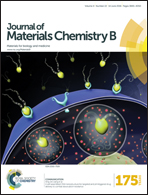The assembly state and charge of amphiphilic β-sheet peptides affect blood clotting†
Abstract
Hydrogels composed of designed β-sheet amphiphilic peptides have been exploited in controlled drug release systems, tissue regeneration and bleeding arrest applications. However the ultimate function of these hydrogels is dependent on a variety of host tissue responses, including blood clotting mechanisms. Here we studied the effect of cationic, anionic and zwitterionic β-sheet amphiphilic peptides on platelet-poor plasma (PPP) coagulation. PPP clotting was monitored by thromboelastography (TEG) in two states: low peptide concentration, dissolved in plasma, and high peptide concentration, assembled in a hydrogel phase. In the dissolved state the positively charged peptide led to immediate phase separation of PPP. The dissolved zwitterionic peptide exhibited minor effects on clotting and essentially no influence in the hydrogel state. The negatively charged peptide in the dissolved state and as a hydrogel retarded fibrin formation and reduced clot strength. This peptide was also found to inhibit blood clotting in spleen wounds in rats, by both interacting with thrombin and depleting Ca2+ from blood. This study demonstrates a systematic approach towards characterization of the effects of self-assembled biomaterials on coagulation in vitro, shedding light on the structure–function relationship useful for the design of new implantable biomaterials.


 Please wait while we load your content...
Please wait while we load your content...